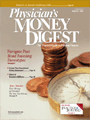Portfolio CHECK-UP
Name: Benjamin Duffy, MD
Residence: North central Florida
Age: 43
Family: Single, no children
Years in practice: 12
Type of practice: Radiologist
Annual income: $240,000
Investment savings: Rollover IRA, $200,000; real estate equity, $1.5 million;and brokerage account, $870,000.
Financial concern: Dr. Duffy has recently left his group practice at alarge hospital in southeast Florida, moved north, and is now on staff at amuch smaller hospital in central Florida. He recently purchased a home andcarries no mortgage, has some real estate investments in southern Florida,and has between his IRA and brokerage account about $1.1 million saved.He has no family financial responsibilities and a relatively modest lifestyle.He estimates that he will be able to save enough annually to fund his retirement,which he anticipates will commence when he turns age 60.
His biggest concern is his brokerage account. It is unprotected from creditors,which is of minor importance to him. What is of major importance tohim, however, is that the account's assets are poorly allocated. He has experienceda lot of volatility in the account in recent years.
The Finance Professor's Solution
Upon examining Dr. Duffy's brokerage account, I found that $546,000 ofthe $870,000 is invested in one common stock, which he inherited from hisgrandmother a few years back. The remaining $324,000 of the account wasinvested in 15 other stocks, concentrated primarily in the financial servicessector. Admittedly, the stock in which his portfolio is concentrated is a goodcompany, however, as of the end of July, the 52-week high for the stock was$50.38 and the 52-week low was $34.63—and he holds 12,500 shares of thissecurity. Additionally, because his grandmother acquired the stock manyyears ago, the cost basis on the stock is very little. For argument's sake, let'srefer to this stock as XYZ Company.
Upon conducting an in-depth analysis of Dr. Duffy's portfolio through whatis known as "tax loss harvesting," he was able to reduce his holding in XYZfrom $546,000 to $424,000 with no tax consequences by disposing of most ofthe other stocks in his portfolio whose losses offset the taxable gain on XYZ.In this way, he was able to reduce his exposure to XYZ from 63% of his overallportfolio to 49%. Additionally, with the proceeds from the sale of the othersecurities, he was able to construct a portfolio utilizing primarily indexedfunds, which are broadly diversified and have low internal expenses. In thisway, he was able to reduce the riskiness measured by standard deviation (ie,volatility) of the newly reallocated portfolio by more than 50%.
For more information, call Mr. Kosky at 800-953-5508or visit www.assetplanning.net.
Thomas R. Kosky and his partner, Harris L. Kerker, are principals of the AssetPlanning Group in Miami, Fla, specializing in investment, retirement, and estateplanning. Mr. Kosky teaches corporate finance in the Saturday Executive andHealth Care Executive MBA Programs at the University of Miami.
